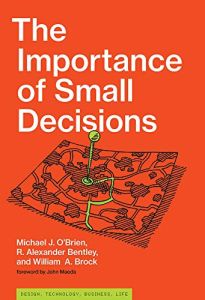Evolution and Decision-Making: Navigating the Complexities of Cultural and Biological Perspectives  In their work, Michael J. O’Brien, R. Alexander Bentley, and William A. Brock delve into the fascinating interplay between biological and cultural evolution, offering insight into the complexities of decision-making and adaptation throughout history. Using examples that range from ancient stone tools to modern-day NFL stars, they provide a broader context for understanding today's information-processing challenges.
In their work, Michael J. O’Brien, R. Alexander Bentley, and William A. Brock delve into the fascinating interplay between biological and cultural evolution, offering insight into the complexities of decision-making and adaptation throughout history. Using examples that range from ancient stone tools to modern-day NFL stars, they provide a broader context for understanding today's information-processing challenges.
The Role of Small Decisions in Cultural Evolution:
The emergence of agricultural societies around 10,000 years ago remains a central question in archaeology. Cultural evolution and adaptation are driven by the cumulative impact of small decisions rather than the direction set by individual decision-makers. David Rindos' 1984 book, The Origins of Agriculture, proposed a phased development of farming, emphasizing that human actions co-evolved alongside agriculture. People's choices are influenced by evolutionary possibilities and social factors, with individuals often modeling their behaviors on others around them.
Understanding Key Evolutionary Terminology:
To comprehend evolution, it is crucial to become familiar with key terms, including "adaptation" and "drift." Cultural selection, similar to biological selection, determines which traits are passed down through generations. Small technological advantages can have significant long-term impacts, influencing both cultural and biological evolution when affecting birth rates.
The Evolution of Economic Decision-Making Models:
Economic decision-making models have evolved, reflecting changing assumptions about human rationality. Early theories assumed human rationality, while more recent ideas explore alternative concepts such as utility, search goods, and experience goods.
The Connection between Fitness and Decision-Making:
Individual and group "fitness" are closely linked to decision-making. This connection can be observed in various contexts, such as sports teams, committees, and the workplace. People learn through both social and individual means, navigating a "fitness landscape" defined by intrinsic utility, social utility, transparency, and opaqueness.
Decision-Making in Academic Publishing:
Similar patterns are observed in the realm of academic publishing, where rapid changes in technology and information availability have led to shifts in decision-making strategies.
Conclusion: Navigating the Modern World through an Evolutionary Lens
Understanding the intricate interplay between biological and cultural evolution is vital for navigating the complexities of the modern world. As decision-making continues to evolve in response to new technologies, expanding information access, and changing social dynamics, individuals and organizations must adapt their strategies to thrive. Developing critical thinking skills, fostering collaboration, and embracing continuous learning will be essential for success in this ever-changing landscape. By studying the history and patterns of decision-making, we can better equip ourselves to make informed choices and contribute to a more resilient and adaptive society.

Case Study: Decision-Making in the Tech Industry
A relevant and contemporary case study that can be explored is the decision-making process in the tech industry, specifically relating to the development and release of new products. This industry is characterized by rapid change and intense competition, which requires companies to make strategic decisions that can significantly impact their success or failure.
One example of effective decision-making in the tech industry is Apple Inc., which has consistently demonstrated its ability to innovate and adapt to changing market conditions. Apple's approach to decision-making involves a combination of top-down leadership, collaboration, and a strong focus on user experience. By prioritizing the needs of the customer and continually refining their products based on user feedback, Apple has successfully maintained its position as a market leader.
In contrast, companies like Nokia and BlackBerry, once dominant players in the mobile phone market, struggled to adapt to the smartphone revolution. Their inability to make timely and effective decisions in response to market shifts led to their decline, as they failed to recognize the importance of touchscreens, app ecosystems, and user-centric design.
These examples illustrate the crucial role that decision-making plays in shaping a company's trajectory, and how cultural factors can significantly impact the effectiveness of these decisions. By applying lessons learned from the study of biological and cultural evolution, tech companies can better understand the forces that drive innovation and adaptation, ultimately making more informed decisions that contribute to long-term success.
In conclusion, the study of decision-making from both cultural and biological perspectives provides valuable insights into the complex dynamics that underlie human behavior and societal change. By recognizing the critical role that small decisions play in shaping our world, we can better equip ourselves to navigate the challenges of modern life and contribute to a more resilient and adaptive society.